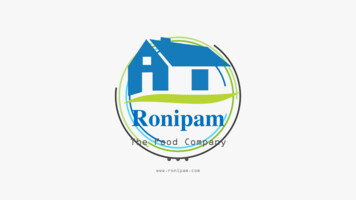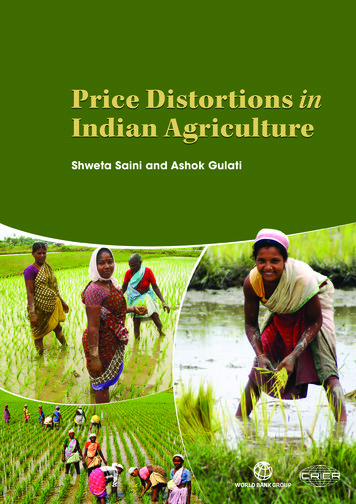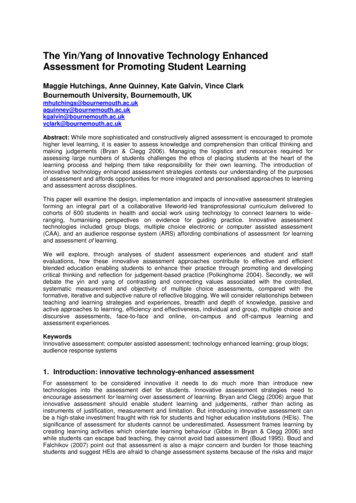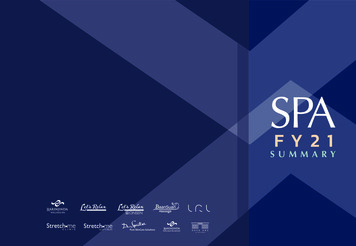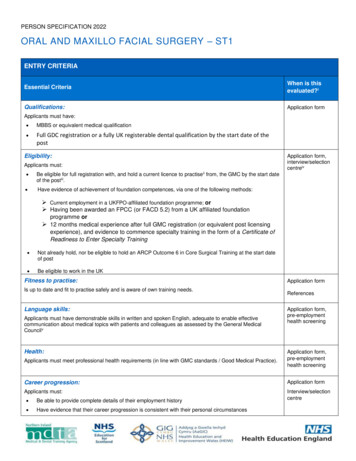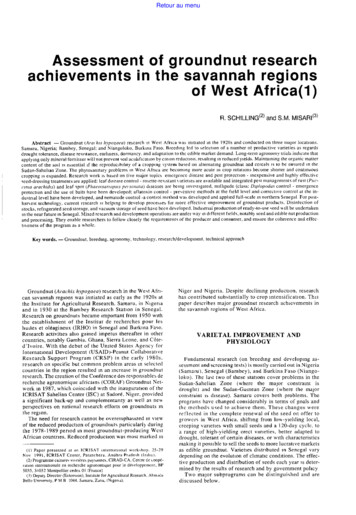
Transcription
Retour au menuAssessment of groundnut researchachievements in the savannah regionsof West Africa(1)R. SCHILLING(2 1and S.M. M1SARi3 IAbstract - Groundnut (Ararh1s hypogaea) re:,carch m West Afnca wa:, m1tiated in the 1920s and conducted on three maJor locat10ns.Samaru, Nigeria; Bambey, Senegal; and Nîangoloko, Burkma Faso. Breed111g led to :-.electmn of a number ot productive varieties as regardsdrought tolerance, disease res1stance, earhness, dormancy. and adaplution to the cdîble market demand. Long-term agronomy trials lndtcate thatapplymg only minerai fert1bzer will not prevent smJ actdlfJCatLOn by cation reductrnn. re:-.ultmg 10 redu.œd y1elds. Maintaming the organic mattercontent of the soi! 1s e.,,sential tf the reproduc1b1l11y of a croppmg 5ystem based on alternatmg groundnut and cereals 15 to be ensured m theSudan-Sahehan Zone. The phytm,anitary problems in We:-.t Afrn:a are bccoming more acute as crop rotatmns become hor1er and contmuouscropping 1s expanded. Research work 1 ba ed on tive major topic" emagcnce disease and pest protection - mexpen ive and htghly effe -frvc :eed-dressing treatments are applied: leaf disease control - rosette-re :1stant ,-ariettes are ava1lable and integrated pe ;t managements of rust (Pucnnta arachidis) and leaf :pot (Phaemsanopsrs JJl'Jsonata) dtseases are bemg mve :t1gated, milhpede (class: D1plupoâa1 control - emergenceprotect10n and the use ot baits have been developed; aflatoxin contrai - preYcntLve methods at the field level and corrective control at the indu :tnal level have been developed, and nernatode contrai -a control rne1hod wa deYeloped and applted full-scale m northern Senegal For posthanest technology, current research is helpmg to develop proce,o,oe for more effective tmprovement of groundnut product . Disintcction ofstocks, refngerated seed storage, and vacuum storage of seed have been developed. Indu tnal produc1îon of ready-to-me :eed v,ill be undertakenm the near future m Senegal. Mixed re5earch and development operatiom, are under way m d1fferent field , notably seed and cd1ble nut productionand processing. They en able researchers to fol low closely the requ1rement of the producer and consumer, and en:-.ure the coherence and effect1veness of the program a a whole.Key words. -Groundnut, breedmg. agronomy, technology. research/development, technical approachGroundnut (Arachis hypogaea) re earch in the We t Afncan savannah reg1ons was imtiated as early as the 1920s atthe Jnstitute for Agricultural Research. Sarnaru. in Nigenaand in 1930 at the Bambey Research Station in Senegal.Research on groundnuts became important from 1950 wlththe establishment of the Institut de recherches pour leshuiles et oléagineux (IRHO) in Senegal and Burkina Faso.Research activittes also gained împetus thereafter in othercountries, notably Gambia. Ghana, Sierra Leone, and Côted 'Ivoire. With the debut of the Umted States Agency forlnternat1onal Development (USA ID )-Pcanut CollaborativeResearch Support Program (CRSP) in the early 1980s.research on specific but common problem areas m selcctcdcountries in the region resulted m an mcrease in groundnutre,;;earch. The creation of the Conférence des rc,;;ponsable derecherche agronomique africa,m (CORAF) Groundnut Network m 1987, which coînctded wlth the înaugurnt1on of theICRISAT Sahelian Center (ISC) at Sadoré. Niger. provideda significant back-up and complementanty as well as newper pectives on national re earch efforts on groundnuts mthe reg1on.The need for research cannot be overempha 1zed m v1ewof the reduced product10n of groundnut ; particularly du ringthe 1978-1989 penod m most groundnut-producing WestAfrican countnes. Reduced productwn was most marked rn(L) Paper presentcd al an ICRJSAT tnternat1onal worbhop. 25-29Nov 1991, ICRISAT Center, Patancheru. Anùhra Pr.ide h l[ndtal.(2) Programme culture\ vivrière pd)' dnne . Cl RAD-CA, Centre de toopérat10n internationale en recherche agrunom14ue pour le développement. BP5035, 34032 Montpellier cede,.01 (Frani.:e)(3) Deput) Director (Exten 1on), lnst1tute for Agncultural Rcsearch. Ahrn.1duBello Umvernty, PM B 1044. S.imaru. 2.Jna, (N1gen,1).Niger and Nigeria. Despite declimng product10n, researchhas contributed sub tantially to crop 1111ensificat10n. Thtspaper describes major groundnut research achtevements inthe savannah reg ions of West Africa.VARIETAL IMPROVEMENT ANDPHYSIOLOGYFundamental research (on breedmg and developmg assessment and scrccning tests) is mostly carried out in Nigeria(Samaru). Senegal (Bambey), and Burkina Faso (Niangoloko). The Ja ,t two of these s1at10ns cover problems in theSudan-Sahelian Zone (where the maJor constramt isdroughtl and the Sudan-Gurnean Zone (where the maJOTcomtraint 1-" d1sea . e). Samaru covers both problems. Theprogrnms have changed consîderably in terms of goals andthe mcthod ; u;;;ed to achieve them. These changes wereretlected in the complete renewal of the seed on offer togrowcr,;; in West Africa. shiftmg from lo-w-y1elding local,creeping vanelles w1th small seeds and a 120-day cycle. toa range of high-yielding crect vaneties. better adapted todrought. tolerant of certain diseases. or w1th characteristicsmaking it possible to sell the seeds to more lucrallvemarketsas edîble g:roundnut. Varietles distnbuted m Sencgal varydependîng on the evolut10n of chmat1c conditions. The effective product10n and distribution of seeds each year 1s determined by the re ults of research and by government pohcyTwo maJor subprograms can be distîngui,;;hed and arediscussed below.
Retour au menu324-Oléagineux, Vol. 48, n 7 - Juillet 1993Drought tolerance subprogramThe drought tolerance subprogram launched m Senegalnow covers central and northern Burkina Faso and mvolvesa wide range of partners in geographical areas affected bydrought (e.g., northeastern Brazil, Botswana). After thegcneral ,drought in the early 1970s, breeding for droughtrcsi stance and short maturity cycle have been given re earchpriority in Nigena, Ghana, Mali and Niger.Physiolog1sts and breeders have been working together inthese countries for several years. and have identified a fewvarieties that may be drought tolerant.Various drought tolerance techniques have been used anda set of tests have been dcveloped. The tests were applîed tothe collection of groundnut varieties available in Senegal.Varietal trials were carried out in the field under nalural orartificial drought conditions. which led to the d1stnbut10n ofvanety 55-437. offered for extension in the northern part ofthe groundnut basin, the most severely drought-affected area(400-650 mm rainfall). This variety. wh1ch is currentlyreleased for commercial production in Niger and the drierzones ofNrgeria. Chad, Gambia, and Cameroon (Table f), isbeing used as a parent in the program underway at Samaru,Nigeria, and at the ICRISAT Sahelian Center (ISC). Niamey.The variety SAMNUT-18 (RRB) released in Nigeria has 55437 as one of the parent sources. The lack of seed dormancytypical ot Spanish and valencia types means that there 1s arisk ot immediate germinat10n if the soil 1s still damp at thetime ot maturity: breeding was therefore geared towards obtaining drought resistant and dormant types destincd to 1mnimize this draw-back in areas that are subJect to late rainfall(600-900 mm). Hence, vanety 73-30, with a 95-day cycle.and 73-33, w1th a 105-day cycle, wcre obtained from Spamsh X Virginia crosses. This material is unique. and was introduced by ICRISAT înto collections and varictal tnals inmost producer countries in the sem1-arid zone. It has beenvery widely distnbuted in Senegal and Gambia (Table I).The varieties are currently under intensive evaluation inGuinea.Drought in the Sahel and Sudan-Sahelian Zone can taketwo forms: short rainy season and low rainfall, typical of h1gher latitude regwn; and long rainy season, but often of irregular distribut10n and often inadequate total rainiall: this occursfrequently in the central and Southern zones.In the northern region, the goal 1s to develop breeding programs geared primarily towards producing early-maturingvarieties from parents 1,vith a 75-90 day cycle. In the centraland southern regions, the aim is to develop variettes w1thphysiological characteristtcs that will enable them to withstandperiods of drought without suffering irreversible damage:the late-maturing vanettes have a higher production potential and their ability to recover after drought at the start orin the middle of their cycle means that they are often chosenill preference to early varieties. A drought adaptation ideotype was defined. on Lhe basis of three main physiolog1calcharacters: root growth, protoplasm1c resistance, and optimum stomatal transpiratton.For a given type of drought, the results enable a definit10nof the adaptatlon characteristics required of the preferred1deotype. Four tests were developed to enable screening ofaround 800 individuals in each breeding cycle, based on protoplasm1c res1stance to heat and drying, by measuring electrolyte escape. on water loss regulat:ion measured usingdetached leaves. and on rooting characteristics, studied in arh1zotron.Producfrdty improvement subprogramThe productivity improvement subprogram covers andcombines the other topics. It takes into account the mamyield components and the quality of the products obtained.depending on local production conditions. The followingtraits are important to brecders: yield (pods. haulms, emergence, and shelling). ecological adaptation (cycle Jength,dormancy, drought tolerance, and disease resistance),response to cropping techniques (soil preparation, fertilization, and mecha11izat10n), and product quality (oil andammo-acid composition. and commercial and organolepticcharacterist1cs ).Nearly 50 vaneties are currently being commercially multiphed in various West Afncan countries (Table I). Most ofthem were obtained at the breeding centers at Barn bey.Niangoloko, and Samaru. and then very widely d1stnbutedthroughout the reg10n. in Carneroon, and m zones of southern Africa with a sirnilar climate They were all chosenbecause of their des1rable traits (productivity, erect habit, oilcontent, and simultaneous maturity). Important traits ofsome of these varieties are given m Table Il.AGRONOMY AND CROPPING SYSTEMSThe apparent decline in groundnut production in WestAfrica had been partly due to nonadoption of improved agronomie practices for obtaining high yields. Unfavorable dimatie cond11ions. characterized by frequent droughts, hightemperatures. and a decline in soil productivity followmgcontinuous cultivation are exogenous factors that have resultedin low yields. Results from research institutes in the regionhave shown, however, that recommended production pract1ces for obtaming high yields include selection of good quality seed for sowing, a weed-free seedbed, Limely sowmgmaintaining a high plant population, application of fertilizers, weed and disease control, and timely harvesting.Despite these recommendations, crop husbandry prachcesfor groundnuts in large areas of West Africa hsve remainedunimproved and the crop is sttll a subsistence crop. Fannersgrow the crop with minimum inputs. which normally entailssowing poor-quality seed oftraditional varieties as a component of mixed cropping systems w1th madequate 1,veedingand no chemical fertilizers or pest management prachces.Increased groundnut productivity is sought both tram improved varieties and by developmg cropping systems likelyto rnake the best possible use of the seed. taking account of: environmental factors (the need to maintain andimprove soil fertility on a long-term bas1s), and socweconomic constraints affecting the ruralenvuonment (land availabihty, equipment andinput costs and instüllation, grant and credit policies. etc.).Intervention strategy: restrictions on intensificationGroundnut research has mcluded studies of the soc10economic environment of production, which is a basicconstraint on the application of research results. Prices andprice fluctuations are a detcrmmmg factor: purchase price,harvest prrces. price paid for inputs, and expected relativemcome govern the farmer's technical decisions and marketopportunities. Groundnut, which 1s a 'drivmg' crop in theSudan Sahelian Zone. proves the suggestion that pricingpolicies are not usually m accordance wtth official declaiations of intention and do not make the most of the technicaland financial resources that are available ior development.There is no other way of explainmg the errattc use of fcrtilizers in West Africa and the dramatic declme in their useover the past decade; the oft-proclaimed mtensification
Retour au menu-325Oléagineux, Vol. 48, n 7 -Juillet 1993TABLE I. - Sorne improved groundnut varieties under commercial production in West African 42248-l 15A48-115B48-37RRB28-20428-2061B 6657-31347-1069-lOtRMP12RMP91KH 149AKH 241D59-426TEJTS 32-1GH-l19-20K 1332-781M513-77190 SariaCN 14554.761Spanish 205Spamsh 6MK374MK383Mam PmtarFlompan RunnerNatal CommonXXXXXXXSh1taochiXTmkPhihppme RedXKumawaFMIXSamaru 38Samaru 61GeorgîaDeli Rose756-17'XXXXXXXICGVs 86053, 86551, and 871 l 91 x Most widely grown vaneues,,2 N Newly relea,cd3. ·1 Prom1 1ng \ane11es, grown ehewhere but still under local adaptation trialsTABLE Il -Characteristics of the main groundnut Yarieties distributed in \\'est AfricaVariety55-43773-3047-lOTe3Ts32-1KH-149 AKH-241 D55-42273-3328-206Barly( 100days)Dom1ancyDroughltoleranceRoseltere ;i ;tanceShellmg rate 70%XXX'XXXXXX100-seed mass XXXXX69-10157-3[3RMP12GH119-20756 A73-2773-28X'XXXXXXXXXXXXX'X
Retour au menu326-pohc1es sometimes saw the denial of credit and a tripling oftertihzer prices, which resulted in the almost total removalof ferhhzers from groundnut and other rotat10n crops.This situation makes it logical to recommend the methodical and w1despread use ot so-called light techniques in thesmall-holder environment, in preference to mev1tably sporadic and expensive heavy practice.s. limited to a fnv farmerswho can afford them e.g., the ploughing/deep phosphate applications/high annual fertilizer rate combmation, which 1sno longer being apphed in Senegal. This realtst1c movcshould be contmued.Farming systems Groundnut intercroppingGroundnuts play a s1gnificant role in the farmmg systemsof West Africa. Although 1t 1s grown as a sole crop to a certain extent, the widespread traditional practice throughoutthe reg10n involves intercropping with cereal crops, part1cularly sorghum (Sorgfwm hicolm) and millet (Pennisetumglaucum). The product10n of groundnut as a sole crop wasfirst dictated by the colonial emphasis on groundnut as a cashcrop. Therefore, sole croppmg research results were not applicable, and therefore not adopted by farmers for the tradition al mixed cropping systems. It is only relatively recentlythat research on mîxed/intercropping systems has been mitiated.Severa\ advantages of mtercroppmg includc: insuranceagarnst complete crop failure due to pests/d1seases and/orweather conditions. grcater total product1vity per umt ofland for mtercrops than for sole crops, supply of a betterbalanced diet for the farm family on a lumted farm land area;better control of weeds and soil eros10n; and avoidance ofexpensl\,e labor costs during the cropping period. In spi te otthese advantages, the lev el of groundnut ptoductivity is stillvery low.One of the controversial issues requiring study is theeifect on groundnuts of the N applied to cereals, and thetransfer of N from groundnut to the associated cereal in situations where the former applies no or msuff1cient N fertilizer, partlcularly when his soi! is lü\\' in organ1c mattercontent. Furthermore, the reduced nodulation and N-fixingactivities of groundnut in intercropping systems would leadto a greater demand on native s01I N by both the groundnutand the cereal component of the crop mixture. Because of thescarclty and high cost of N fertilizers ta the small farmers,however. the productivity aod ferttlity levels of their farmshave contrnued to deteriorate. This is particularly aggravatedby the fact that the crop residue is removed for hvestockfeed, fuel. and bindmg instead ot mcorporating 1t back intothe SOJl.There is a need for research on biological N-fixation,s1milarly, studies are required on the cho1ce of crop combtoations and variehes. optimum sowmg dates. plant arrangement/geometry in intcrcrops, optimum fertilizer appl1cat10nlevels, cho1ce of herbicides, rotat10n schedules, pest anddise a se management, and the economics of product10n inintercropping systems. Sole croppingThe groundnut/cereal rotatton is a common practice whereverthe crop bas evolved from self-sufficiency ta market economy, particularly in Senegal and other northern regions ofthe West Afncan cropping area. Advantages of the systemare to be found m better d1sease and pest controL as well asm the introduct10n of animal-drawn tillage and specific crophusbandry. including fertilization. These factors will resultin a significant increase of total land and labor productiv1ty,in areas where fallow (a compulsory component of the tradit10nal cropprng systems) is becoming scarce. The eftect ofOléagineux, Vol. 48, n 7 - Juillet 1993natural fallow or ploughed fallow on groundnut and cerealy1eld was compared with yields for the same crops growncontinuously in rotation trials over severa\ dccades m Senegal, Burkina Faso, aod Nigena.Grass fallow, essentially compnsmg wild grasses, eauhelp to prescrve the soil profile and slightly increase theorganic matter 111 the soil. It hmit.s, although it does notentirely eliminate. degradation and yield reductions 111extensive croppmg systems and in regions wilh particularlyunfavorable soils and chmate. Howcver, with good soil andchmatic cond11lons, the length of the fallow period can bereduced in accordance with the fertilizers applied, or abandoned altogether.Of the cropping systems tested, those which prove themost profitable for the farmers. while maintammg soil fertllity,are the most 'highly developed' systems. combining organicand minera! fcrtilizer as \Vell as usmg harvest res1ducs.In high-risk areas (with low ramfall, vcry sandy tïoils,susceptible to eros1011. and where repeated ploughing isnot adv1sable). groundnut/cereal/fallow rotation 1s to be recommended; in more propitious areas, continuous groundnut-cereal growing can be considered.Jn both cases, it is essential to maintain the organic maltercontent of the soil: in continuous cropping, applying onlyminerai fertilizer will not prevent soil ac1d1f1cation by cationreduct10n. even tf is satisf1es the major elemcnt requirements, and the subsequent reduction in fert1J ity leads toreduced yields. Despite the problems posed by ava1labilityof organic matter, th1s factor is essentrnl if the reproducibihty of a cropping system based on alternating groundnut andcereals is ta be ensured in the Sudan-Saheltan Zone. Fertilizer studiesIn West Afnca. the main fertilizers applied to gronnrlrmtcon tain phosphorus. calcium. and sulfur.Fertdizer stud1es were based on research on physiologyand mrneral nutrition. bac.ked up by factorial fertihzer trials.The critical levels for N. P, K, Ca, Mg, and S werc detennincdby leaf analysis. The contents of these elements. measuredby leaf-sample analys1s, prov1de useful information on plantnutrition and on the deficiency thresholds; m fact. th1sinvolves N x dry mass, P X N and S x N cntlcal curves. Inaddition to soi] analyses and field experîments, this technique made it possible to defme the most cost-effective formulasfor each zone, based on response and cost curves. A fertthzermap has thus been produced for Nigeria and Senegal. Thisbas governed fertilizer application for several decades andsticks closely ta local soi] and chmatic cond1t10ns. There isa dominant P deficiency except in the Th1es region (Senegal).where phosphates are naturally abundant. Sorne of the fertilizer recommendat10ns in the reg10n are: application ofsoluble forms of Pin the northern reg10n: graduai mcorporation of Jess soluble tricalcic phosphates 111 the central andsouthern regions; and correct10n of Mo deficiency in certamareas by mixrng molybdate (30 g ha-1) directly wnh the seedfongicide treatment or in the form of Nutramine.In other producrng countries, particularly Nigeria, thetercthzers appl1ed on groundnut consi ' t of combined man ure(2.5 to 7.5 t ha-1) and single super-phosphate (60 ta 100 kgha-1) applications, with a view to mamtaining sufhcientlevels of orgamc matter in the s01l and ta correcting themajor def1c1encies (S and P). The current recommendationusing minera] fertihzers alone requires the application of300 kg ha-1 of smgle superphosphate and 54 kg ha-1 ofmuriate of potash before sowmg.There is a general Ca defic1ency throughout much of theWest Afncan semi-arid savannah soils where ernpty pods orpoor pod filling 1s a problem. Although single superphosphate and gypsum have been found to remedy the situation,it bas been advocated that genetic varia110n can be exploited,
Retour au menuOléagineux, Vol, 48, n 7 - Juillet 1993-327particularly in the light sandy soils of the Sahel. Since podsize has been estabhshed as a factor influencing the Ca nutrition ofpods, wh1ch is dependent on surface. volume ratio,small pods are less likely to experience Ca defictency thanlarge pods. Research efforts have therefore been directed atidentifying varieties w1th desirable agronomie characters.optimum pod size, and efficient exploitation of available Ca.Senegal, and other countnes. Sorne of thesc recommendations are: use of selected varieties; seed fongicide treatments; sowing in rows. at the right time, nght density andright depth, Weed control Jight mechanizatîon using ammal traction (sowmg, hoeing, hftmg);Weeds growing at the begmning of the season can have anextremely adverse effect on young groundnut plants. andadequate weeding at the nght time ,s necessary for crop success. Early manual or mechanical weedmg also makes 1tpossible to loosen the soi! and dig in the fertilizer. thus maximizing its effectiveness. This cropping technique ts a significant step forward m increasmg the growers' technicalskills, and mechanical weedmg is now w1despread in maJorproduction areas (particularly in the Senegal groundnutbasin and northern Nigeria).Herbicide formulas have also been tested successfully:Lasso diuron, and Cotodon , in Burkina Faso; Cotodon Gramoxone , and Gesaten in Senegal; and Igram Combi and Dual in Nigeria. However, the use ofherbicides by farmers is limited due to Jack ofre ;ources andapplication difficulties. This 1s partîcularly diff1cult in mtercropping systems. light mrneral fert1lizer apphcatlon, spread and dugin at the nght time: weeding at the right time: and harvesting at the right stage of matunty.The interaction of these techniques and the esumates ofprofits obtained in terms of yields (in agronomy trials) aregtven in figure 1.The wide-scale applicatrnn of these techniques in Senegalduring the 1960s led to a general shift from manual tomechanized agriculture. both for groundnut (which funded thesh1ft) and for cereals grown in rotation with it. Althoughsome of these recommendatlons have been adopted m otherWest African countnes, albe1t poorly. mechanization lS notas wide-spread as in Senegal where animal traction practiceshave been developed.The strategy that was adopted necded to takc the mm1mumnumbcr of nsks in a drought-prone area. It required:Recommended technical practicesResearch organizat10ns have made precise recommendations on the techmques developed to 1mprove the mainrainfed crops (groundnut and millet-sorghum) in Nigeria,YieldNumber of plantsharvcsted rust1c varieties. capable of withstanding difficultsoîls and climatlc condltions;1hectareYicldper plant-x----/ Genetie factors --S-eed-- LNumbcrpl of1eemtsorgedDisinfection ! 30%LI ----- 15 %HighDensitics1Number of seedssownSowing designon 60 spacing2'k:ell whcelstEnvironmentalfactorsBreeding/ 30 %Soil a·,mate (water)/erul NaturalJmprovedRotationFertilizers 40%Drawn equipmentSowers - Hoes- Fenilizerspreaders;; .11----------------------------------------·FIG. 1.- Principal groundnuL y1eld factor . (Source pi opo.Hflon pour/' m1gme11tarw111 aprde ,le, 1e11demen1. de/' a10 /11de m1 Sé11 sg,i/11mff les huiles er oléaginnuilnsmur de reche1 tf1e agronomiques trop1wles el des rnltw e.1 1'11'11 )1 es (l RJlO !RAT). 1963)i11Wf//F d,'reche1 d1ci
Retour au menu328 -Oléagineux. Vol. 48, n 7 - Jmllet 1993 low-cost, multipurpose equipmcnt and hitchedtools; light fertil1zer rates, based on short-term cost effectiveness; and effective mtegration of traditional cropping practices and tarming calendar.CROP PROTECTIONGroundnut is attacked by numerous predators. and thedamage caused is reflected in a s1gnificant tall in productiv1ty and poorer product quality. Attacks by arthropods (msects and myriapods), worms (nematodes). and pathogens(fungi and vtruses) are seen, in addition to weed competition. The phytosanitary problems in Africa are becommgmore acute as crop rotat10n periods become shorter, the system of cropping tw1ce a year becomes more w1despread. andinternat10nal seed exchanges develop. Researchers have stud1ed these problems in terms of cropping practices, varietalimprovement, and chemical and technological treatments:we shall discuss five main topics.Emergence disease and pest protectionNumerous fungi and insects (termites. coleoptera) andmyriapods (julids) attack seeds and seedlings du ring germination and lead to emergence lasses of up to 50%. Treatingseeds with fongicides msectic1des is essential, and hasbeen stud1ed w1dely. A dry coating techmque bas beendeveloped and several formulas have proved their effectiveness (benomyl captafol. captan carbornlfan. etc.). Granox (10% benomyl, 10% captafol, 20% carbofuran) givesexcellent results m Senegal (average effect 33% at the densitJes generally practiced). Until 1ecently when lhey werephased out, Aldrex T (thiram 25% aldrin 25%) and fernasan D (th1ram 25% lindane 20%) were the major routine seed dressing chemicals used in Nigeria and Ghana.Apron Plus (metalaxyl captan furathiocarb) and Marshall ST (carbos,ulfan thuam) are being tested underNigerian conditions. These mexpens1ve but highly effectivetreatments are applied on a very wide scale, and products aredistnbuted to farmers in a11 the areas where a specializedservice provides seed supplies. The fongicide component ofthe treatment is by far the more important, and the hypothesis that fungi become established in wounds that alreadyex1st has been proved. Industrial coating and tJ1e distnbuüonof ready-to-use shelled, fungicide-treated seeds is currentlyat the preextens10n stage in Senegal.Leaf disease controlFour diseases (rosette, early and late leaf spoL and rust)have an economic impact on groundnut productivily in Africa.Disease mc1dence 1s higher the further one is to the south ofthe savannah area. Virus diseaseRosette is a virus di ease transmitted by an aphid. Aphiscraccil'ora. Resistant vaneties have been bred in BurkmaFaso. Senegal, and Nigeria. Although the transmissionmechanism and the epidemiology of the dtsease in fa1rlywell understood, the way the virus acts is not yet entirelyclear. Rosette can devastate harvests over vast areas if cltmaticconditions m a given year are propitious for early infestation; although traditional srnall-holders do not have accessto chemical treatments, the use of resistant varieties makesdisease prevention possible irrcspective of the circumstances. Varieties that have been extended in areas whererosette is endemic and have proved highly successtul are69-101 in Nigeria, Casamance, Guinea-Bissau, and Chad:RMP 12 and RMP 91 in Burkma Faso, Chad, and Mozambique: and SAMNUT-16 iM554.76 [) and SAMNUT-3(M25.68) m Nigeria. ICRISAT has included them in its varietal development and internatwnal varietal trial program. Leaf spot diseasesLeaf spot diseases (early and latc) are een in varyingdegrees where,,er groundnut 1s grown. They lead to premature defolrntîon and yield reductions of up to 50%. Manyproducts and formulas have been tested, but chemicalcontrol in the small-holder cnvironment is always dtfficult.particularly ince it is often neccssary to treat against rustand leaf spot diseases at the same t1mc. Only mancozeb(D1thane@ M-45) is effective against all three d1seases, buthigh cost and the necessary weckly apphcahon frequencyrules it out for small fanners. Preventive cropping techniques limll disease incidence: alternating groundnut/cereals.early sowing, applying mmeral fertilizers (particularly sulfur applications), removing haulms. and elimmating harvestresidues (burying or burning). RustRust first appeared Ill West Africa some time after 1970,and is spreading quickly. Studies are currently concentratedon breeding resisrant vanet1es, pathogen b10logy and epidemiology. and chemical trcatments. [nformation has been obtained on how rust survives on site from one year to anothcr.on epidemiology in relation to climatologie al parameters, onthe ho ;t-pathogen relationship (cntlcal infecuon penods intenns of y1eld), on methods for assessing resistance (as aback-up to breeding), on preventive agronomie methods, andon chemical control. It has been estabhshed that rust, as wellas leaf spots (early and ];He), can be contro!led w1th fongicides other than mancozeb. The chemicals carbendaz1m, tridemorph maneb or tridemorph MBC maneb, which aresystemic in action, require only 4-5 applicat10ns pcr seasonas opposed to 8-l O w1th mancozeb. Spraying of Calixin-M ,commencîng at first appearance ot symptorns and appltedfortnightly, was also found t
Research Support Program (CRSP) in the early 1980s. research on specific but common problem areas m selcctcd countries in the region resulted m an mcrease in groundnut re,;;earch. The creation of the Conférence des rc,;;ponsable de recherche agronomique africa,m (CORAF) Groundnut Net work m 1987, which coînctded wlth the înaugurnt1on of the
